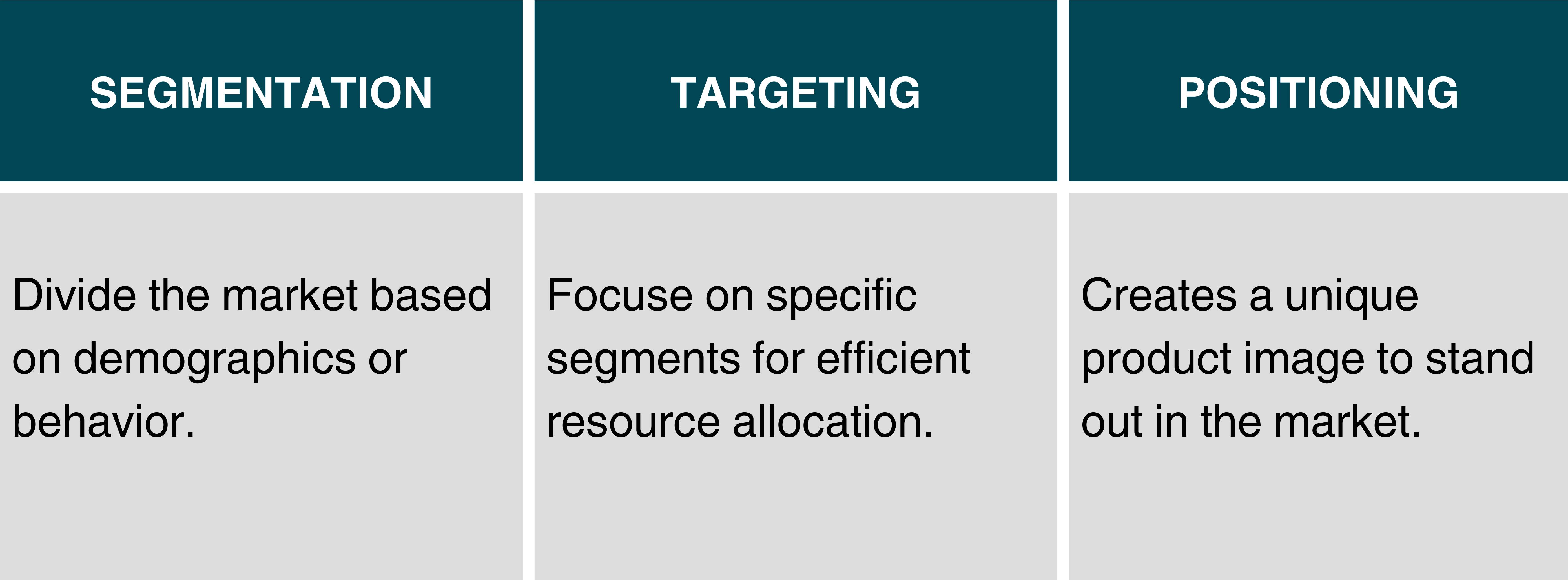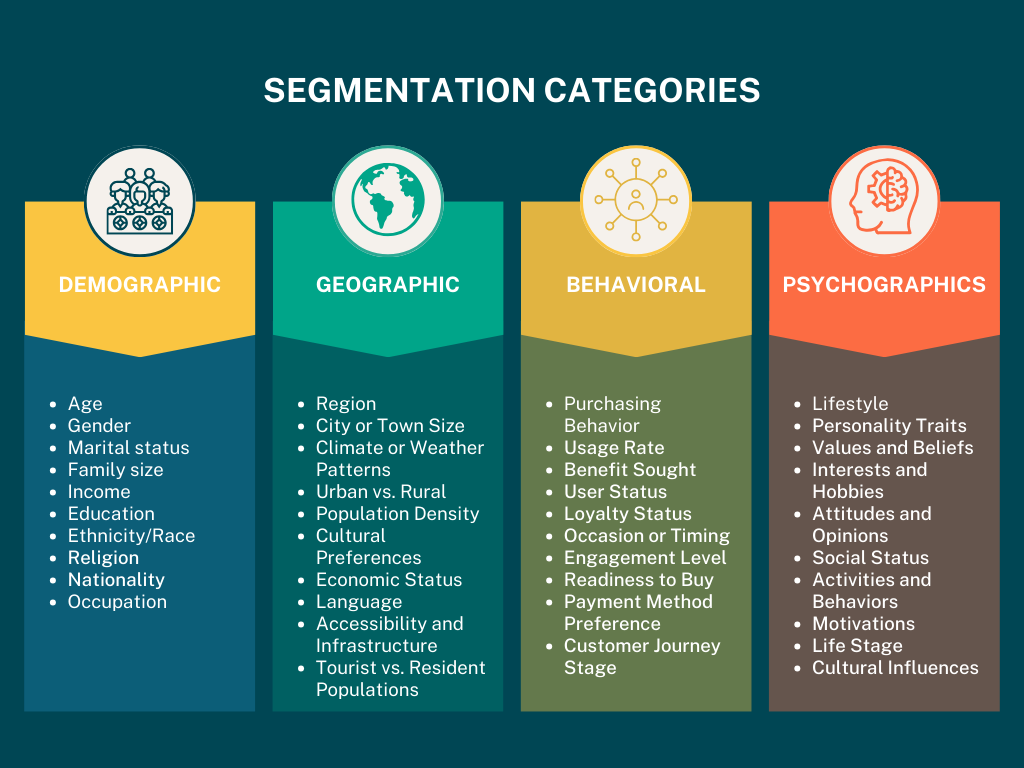Today the Segmentation, Targeting, and Positioning (STP) Marketing Model is one of the most commonly utilized models, widely employed in practice and acknowledged by marketing leaders for its effectiveness in promoting streamlined and efficient communication practices.
STP marketing, which focuses on enhancing commercial effectiveness through the identification of valuable business segments and the crafting of tailored marketing mixes and product positioning strategies for each customer group, underscores the importance of customer personas. Whether you’re new to STP or an experienced practitioner, assessing and maximizing every opportunity to connect with, convert, and engage customers is essential. Customer personas play a pivotal role in this process by offering a comprehensive view of different customer segments. Businesses investing in creating and utilizing accurate personas can refine their marketing strategies, leading to more effective and impactful campaigns.
What is STP in Marketing?
STP Marketing, an acronym for Segmentation, Targeting, and Positioning, is a powerful approach that breaks down the broad market into smaller, manageable segments to tailor marketing strategies effectively. The essence of STP lies in understanding that a one-size-fits-all approach is no longer viable in today’s diverse market landscape.
Through market segmentation strategies, businesses can categorize their potential customers based on various criteria such as demographics, psychographics, or behavior. This segmentation paves the way for effective audience targeting methods, where businesses focus their resources on the segments most likely to convert.
The final step, positioning, involves crafting a unique market presence that sets a brand apart from its competitors. This involves a mix of brand positioning techniques and differentiated marketing tactics, ensuring the brand resonates with the targeted segment.
In essence, STP Marketing is a roadmap for businesses to identify their target market, understand their needs, and position their offerings in a way that appeals uniquely to each segment.
The Benefits of Using the STP Model
The STP model offers myriad benefits to businesses aiming for precision and efficiency in their marketing efforts. First and foremost, it enables a deeper understanding of the market through effective target market identification. By segmenting the market, companies can identify niche marketing strategies that allow them to serve specific customer groups more effectively.
Additionally, STP aids in optimizing the marketing mix, ensuring that the product, price, place, and promotion are perfectly aligned with the needs of the target segment. This targeted approach not only increases the efficiency of marketing efforts but also ensures a higher return on investment.
Positioning tactics in marketing, a key component of the STP model, help in establishing a strong brand presence tailored to the specific expectations of different customer groups. This strategic positioning leads to enhanced brand loyalty and customer retention.
Overall, the STP model is instrumental in creating marketing campaigns that are not just effective but also cost-efficient and customer-centric.
Why Personalization is Key in Marketing
In the current marketing landscape, personalized marketing is more than a trend; it’s a necessity. Personalization in marketing means crafting strategies and messages that cater to the individual preferences and needs of consumers. This approach is vital because today’s consumers expect brands to understand their unique needs and offer solutions that resonate personally with them.
Personalization is deeply rooted in the STP marketing model, as it leverages insights from behavioral segmentation in marketing to deliver relevant content and offers. It goes beyond traditional demographics to include psychographic and geodemographic segmentation methods, ensuring a more nuanced understanding of the customer. Personalized marketing leads to enhanced customer experiences, increased engagement, and, ultimately, higher conversion rates.
Brands that excel in personalization create a sense of individual care and attention, which is important in building long-term customer relationships and loyalty.
What is the STEP Formula?
While STP stands for Segmentation, Targeting, and Positioning, the STEP formula adds an essential element – Engagement.
This formula represents a comprehensive marketing approach that encompasses not just identifying and reaching the target audience but also actively engaging with them.
Engagement is the bridge that connects a brand with its customers, making the marketing efforts more interactive and responsive. This formula starts with strategic targeting in advertising, where businesses identify their audience and tailor their marketing strategies to these specific groups. Engagement here involves using personalized marketing techniques to create meaningful interactions with the audience.
Brand identity development and market positioning analysis are then employed to establish a strong brand presence that aligns with the identified segments.

The STEP formula is a holistic approach that ensures not only the identification and targeting of the right audience but also their continuous engagement and loyalty, leading to a more dynamic and effective marketing strategy.
Segmentation Strategies
Segmentation is the process of dividing a broad customer base or a large audience into distinct groups that share similar characteristics.
This technique is beneficial as it narrows down a large audience into more manageable subgroups, each defined by particular traits. Given that it’s impractical for businesses to market their products universally, segmentation sharpens the focus on those individuals who are most likely to benefit from your offerings.
For instance, if you’re managing marketing for a clothing retail store, you might segment your customers based on their fashion preferences and lifestyle choices.
You could create distinct segments for customers interested in business attire, casual wear, athletic/sportswear, and formal wear. A customer looking for professional business attire has different needs and preferences compared to someone shopping for athletic wear. By segmenting your audience in this way, you can tailor your marketing strategies to appeal specifically to each group, even though you’re promoting the same clothing brand. This approach allows for more targeted marketing and potentially increases customer satisfaction and sales in each segment.
To implement segmentation effectively:
Implementing segmentation effectively is a strategic process that involves understanding your market and tailoring your products and marketing efforts to different consumer groups. Here are key steps to effectively implement segmentation:
- Gather Market Insights: Gather data on your potential customers through surveys, interviews, focus groups, online market research, and market analysis. This research should aim to understand customer needs, preferences, behaviors, and demographics.
- Identify Segmentation Variables: Based on your research, identify relevant segmentation variables. These could be demographic (age, gender, income), geographic (location, climate), psychographic (lifestyle, values), or behavioral (purchasing habits, usage rate).
- Segment Your Market: Divide your market into distinct segments using the identified variables. Ensure each segment is measurable, accessible, substantial, differentiable, and actionable.
- Analyze Market Segments: Evaluate each segment for its attractiveness and profitability. Consider factors like segment size, growth potential, competition, and alignment with your company’s strengths and objectives.
- Select Target Segments: Choose which segments are most viable and aligned with your business goals. Not all segments will be equally valuable or feasible to target.
- Develop Segmentation Strategies: For each target segment, develop tailored marketing strategies. This could include specific messaging, product modifications, pricing strategies, distribution methods, and promotional tactics that resonate with each segment.
- Customize Products and Services: Adapt your offerings to meet the specific needs and preferences of each segment. Customization can range from simple packaging changes to developing entirely new products.
- Execute Marketing Campaigns: Implement your marketing strategies for each segment. Ensure that campaigns are focused and tailored to the characteristics and needs of each target group.
- Measure and Analyze Results: Use analytics and KPIs to track the performance of your segmentation strategies. Monitor sales, market share, customer feedback, and other relevant metrics.
- Refine Segmentation Strategy: Based on your analysis, make necessary adjustments to improve and refine your segmentation approach. Stay adaptable to changes in the market or consumer behaviors.
- Continuous Monitoring: Regularly revisit your segments to ensure they remain relevant. Market dynamics can shift, necessitating adjustments in your segmentation and targeting strategies.

Audience segmentation can be based on various factors:
- Demographics: Categorize customers by age, career, economic status, or gender.
- Geography: Organize customers by their location, whether by country, state, city, or by urban, suburban, and rural areas.
- Behavior: Segment your audience using data from past purchases, website activity, reviews, and communication preferences.
- Psychographics: These include less tangible factors like attitudes, lifestyles, and interests.
While there are numerous other segmentation methods — such as life stage, technographic data, or transactional data — these four are among the most commonly used. You may also develop your own unique framework for segmenting your audience.
Targeting Methods
Why is it Important to Identify and Understand Your Target Market?
In STP Marketing strategies, identifying and understanding your target market is important. This process, known as target audience identification, involves analyzing consumer behavior segmentation to determine the most profitable segments to target.
Understanding your target market enables a business to tailor its products, services, and marketing efforts to meet the specific needs and preferences of its audience.
It’s about creating value that resonates with a particular group, thereby increasing the effectiveness of marketing campaigns and enhancing customer satisfaction.
Best Targeting Tactics
The best targeting tactics in STP Marketing often involve a combination of marketing segmentation techniques and audience profiling in marketing. By employing data-driven approaches, such as market research and analytics, businesses can gain insights into the behaviors, preferences, and needs of different market segments. Strategic targeting in advertising then becomes more focused and impactful as messages are crafted to appeal directly to the identified segments.
Moreover, incorporating niche marketing tactics can enhance precision in targeting. This involves tailoring strategies to specific, well-defined niche markets, ensuring that messages resonate strongly with a particular audience. Additionally, the use of natural language processing applications in marketing can further refine targeting tactics by analyzing consumer language and sentiment, leading to more personalized and effective marketing strategies.
What are the best #niche #marketing strategies? @_SarahHowes has a few ideas: https://t.co/dbgpyPeNTd pic.twitter.com/cCoeLLExHJ
— Commonwealth (@CommonwealthFN) June 14, 2017
Positioning Tactics
What is Positioning in Marketing?
Positioning in marketing refers to the process of establishing a brand’s image and identity in the minds of the target audience. It’s about differentiating the brand from competitors and creating a unique impression that resonates with consumers.
“Positioning is the act of designing the company’s offering and image to occupy a distinctive place in the mind of the target market”
Philip Kotler
Market positioning analysis plays a pivotal role in this, helping businesses understand where they stand in the market and how their target audience perceives them.
Effective positioning involves aligning the brand’s values, messaging, and image with the expectations and needs of the target market.
Best Positioning Methods
Positioning techniques involve a combination of brand identity development and strategic communication. This includes defining a clear brand mission, vision, and values that align with the target audience’s interests and beliefs.

Image by Freepik
Effective brand storytelling, visual identity development, and consistent messaging across all marketing channels are also vital.
Additionally, businesses can utilize consumer feedback and market research to refine their brand positioning continuously, ensuring it remains relevant and appealing to their target market. Furthermore, in an increasingly digital world, leveraging online platforms for brand positioning has become essential. This includes utilizing social media to engage with customers directly, creating content that reflects the brand’s personality, and using targeted digital advertising to reach specific audience segments.
Brands can also benefit from collaborations and partnerships that align with their identity, further reinforcing their position in the market. Influencer marketing, for instance, can be a powerful tool in this regard, as it allows brands to connect with audiences through trusted and influential figures.
Positioning Tactics in Marketing
Positioning tactics in marketing focus on how a product or service is perceived relative to its competitors. This can involve emphasizing unique selling points, creating a distinctive brand personality, or focusing on a specific aspect of the product that is valued by the target audience. Utilizing consumer behavior segmentation, businesses can identify what matters most to their customers and position their offerings accordingly.
Positioning tactics in marketing are not just about standing out; they’re about creating a unique identity that captivates and retains the target audience. Through careful analysis of consumer behavior and a consistent brand personality, businesses can effectively position themselves in a way that not only attracts but also builds lasting relationships with their customers.
These tactics are integral to STP Marketing strategies, playing a pivotal role in the success of a brand in the competitive marketplace.
How to Incorporate the STP Model into Your Marketing Operations
Practical Insights into Implementing STP Marketing Strategies
Implementing STP Marketing strategies begins with a comprehensive understanding of your market and customers. The first step is to engage in thorough market segmentation strategies. This involves dividing the broader market into smaller, distinct groups based on various factors like demographics, psychographics, and behavior. Behavioral segmentation in marketing, categorizes consumers based on their purchase behavior, lifestyle, and usage patterns, providing deeper insights for targeted marketing efforts.
Once the segments are identified, the next step is target market identification. This is where audience targeting methods come into play. It’s essential to understand which segments are most valuable and likely to respond positively to your offerings. Targeting these specific groups ensures that marketing efforts are focused and effective.
The final step is positioning. Positioning tactics in marketing are all about crafting and communicating a unique brand image that resonates with the targeted segment.
This can be achieved through brand positioning techniques, which involve differentiating your brand from competitors and emphasizing unique selling points that appeal to your target audience.
Marketing Mix Optimization for Enhanced Effectiveness
Marketing mix optimization is pivotal in ensuring the effectiveness of your STP strategy. This involves adjusting the 4Ps to suit each target segment.
Niche marketing strategies might require tweaking the product features or pricing to cater to the specific needs of a niche market. Geodemographic segmentation methods can inform where and how to distribute your products, ensuring they reach the right audience.
Differentiated marketing tactics play a key role here, allowing for the customization of promotional activities to suit different segments. This might involve personalized marketing communications tailored to the interests and behaviors of each segment.
The goal is to create a marketing mix that aligns perfectly with the needs, preferences, and behaviors of each targeted segment, thereby maximizing the impact and efficiency of your marketing efforts.
![]()
Image by rawpixel.com on Freepik
Incorporating the STP model into your marketing operations requires a delicate balance of analysis, strategy, and creativity.
By understanding and applying these principles effectively, businesses can ensure that their marketing efforts are not just seen and heard but resonate deeply with their intended audience.
Examples of STP Marketing
STP Marketing has gained widespread acceptance among brands in various industries, underscoring its adaptability and demonstrated success.
Take the fashion industry, for instance, where brands typically divide their market according to age, gender, income level, and style preferences.
For example, a high-end fashion label might focus on wealthy customers who prioritize exclusivity and premium quality, thereby establishing itself as a symbol of sophistication and luxury. Conversely, a brand specializing in athletic wear may cater to sports enthusiasts and athletes, highlighting the durability and functionality of its products in its marketing.
The technology sector also provides a clear illustration of this strategy. Technology firms often employ behavioral segmentation to cater to customers based on how they use technology and their specific tech needs. A company manufacturing smartphones might aim at tech-savvy individuals seeking advanced features and innovation, positioning its devices as the forefront of technological progress. Alternatively, another company might appeal to budget-conscious consumers, marketing its smartphones as cost-effective yet dependable options.
Automotive Industry
Car manufacturers often use STP Marketing to target specific segments of the market. For instance, a luxury car brand might target affluent individuals looking for status symbols and premium features, positioning its vehicles as symbols of success and luxury. Conversely, another brand might focus on families, emphasizing safety, reliability, and space, positioning their cars as the perfect family vehicles.
Beverage Industry
The beverage industry provides clear examples of STP Marketing. A soft drink company might segment its market based on age and lifestyle. For young adults, they might promote an image of fun and adventure, while for health-conscious consumers, they might offer a low-calorie or sugar-free option, positioning it as part of a healthy lifestyle.
Telecommunications
Telecom companies often use geodemographic segmentation methods to target different regions with tailored services. In urban areas, they might focus on high-speed internet and tech-savvy consumer needs, while in rural areas, the focus might be on reliability and coverage.
Retail Banking
Banks use STP Marketing to offer personalized products for high-net-worth individuals who might have premium services, positioning these as exclusive and elite. For younger customers, they might focus on easy online banking solutions, positioning these services as convenient and time-saving.
Hospitality and Tourism
The hospitality sector uses niche marketing strategies extensively. Luxury hotels target affluent travelers with exclusive amenities, positioning themselves as the epitome of luxury and comfort. Budget hotels, on the other hand, target cost-conscious travelers, emphasizing value and convenience.
E-Commerce
Online retailers use differentiated marketing tactics based on consumer buying habits and preferences. For instance, they might target busy professionals with quick delivery options and a seamless shopping experience, positioning their platform as efficient and user-friendly.
Final Thoughts
STP Marketing, which encompasses Segmentation, Targeting, and Positioning, is essential for developing effective marketing strategies. It plays a vital role in understanding and appealing to target markets, personalizing marketing approaches, and optimizing the marketing mix. More than a tactical approach, STP is a strategic imperative in today’s competitive and diverse business environment. By adeptly segmenting the market, targeting the right audience, and positioning the brand effectively, businesses can enhance customer relationships, improve market relevance, and achieve sustained success. STP Marketing is not merely about reaching audiences but about resonating with them, creating meaningful connections, and standing out in a crowded marketplace.